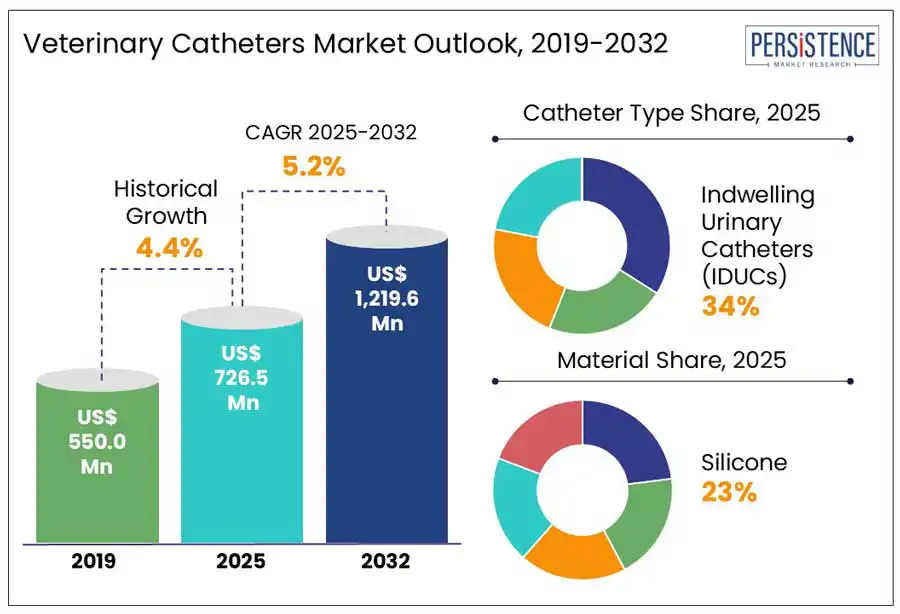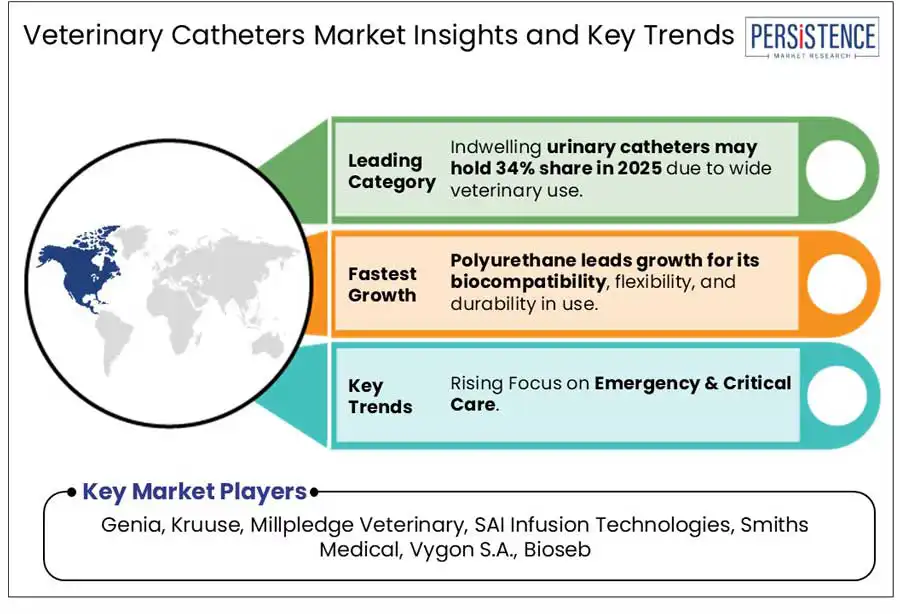Industry: Healthcare
Published Date: April-2025
Format: PPT*, PDF, EXCEL
Delivery Timelines: Contact Sales
Number of Pages: 180
Report ID: PMRREP35198
The global veterinary catheters market size is anticipated to reach a value of US$ 726.5 Mn in 2025 and will likely attain a value of US$ 1,219.6 Mn to witness a CAGR of 5.2% by 2032. According to a Persistence Market Research report, the veterinary catheters market is growing steadily, driven by rising pet ownership, increasing veterinary procedures, and advancements in catheter technology. The demand for minimally invasive treatments in companion animals and livestock is fostering innovation, leading to the development of specialized, biocompatible, and flexible catheters.
The prevalence of chronic diseases in pets, such as kidney disorders and cardiovascular conditions, is further fueling market expansion. North America and Europe lead due to high pet care spending, while Asia Pacific is emerging as a key growth region. The market also benefits from greater awareness of pet healthcare and improved veterinary infrastructure.

Key Industry Highlights:
|
Global Market Attribute |
Key Insights |
|
Veterinary Catheters Market Size (2025E) |
US$ 726.5 Mn |
|
Market Value Forecast (2032F) |
US$ 1,219.6 Mn |
|
Projected Growth (CAGR 2025 to 2032) |
5.2% |
|
Historical Market Growth (CAGR 2019 to 2024) |
4.4% |
One of the key factors driving the veterinary catheters market is the rising incidence of chronic diseases in pets, including diabetes and kidney disorders. These conditions often necessitate long-term treatment and continuous monitoring, increasing the demand for reliable catheterization solutions. According to the American Veterinary Medical Association (AVMA), nearly 50% of pets over the age of 10 are diagnosed with a chronic illness, highlighting the growing need for veterinary interventions. Additionally, advancements in catheter technology, such as biocompatible materials and innovative designs, have enhanced patient outcomes and boosted adoption rates among veterinarians.
One of the major challenges is the high cost associated with advanced catheterization procedures, making treatment unaffordable for many pet owners. Urinary blockages in male cats are a common emergency that often requires catheterization and hospitalization. Non-surgical treatment for a urinary blockage typically costs between $750 and $1,500, but if a cat experiences recurrent blockages or requires surgery, expenses can exceed $3,000. The total cost depends on factors like duration of hospitalization, type of hospital, and location. These high expenses often lead to delayed treatment or euthanasia, limiting market accessibility and adoption.
The global surge in pet ownership and increased spending on animal healthcare significantly bolster the veterinary catheters market. As of 2024, the worldwide pet population reached approximately 1 billion, with cats slightly outnumbering dogs. In the United States, 66% of households, equating to 86.9 million homes, own pets. This rise in pet ownership is accompanied by a notable increase in pet-related expenditures.
In 2023, Americans spent around $150.6 bn on their pets. Specifically, veterinary care and related products are expected to account for approximately $39.5 billion of this expenditure. The growing financial commitment to pet health underscores a heightened demand for advanced veterinary medical devices, including catheters to support comprehensive animal healthcare services.
Indwelling urinary catheters are leading the catheter type category in the market and are projected to hold approximately 34% of the market share in 2025. Indwelling Urinary Catheters (IDUCs) are leading in the Veterinary Catheters Market due to their widespread use in managing urinary retention, post-surgical care, and critical care conditions in animals. These catheters are commonly used in small animals like cats and dogs, especially in cases of urinary obstructions, kidney disease, and post-operative monitoring. Unlike other catheters, IDUCs are required for extended periods in hospitalized or post-operative animals. The increasing prevalence of chronic kidney disease (CKD) and urinary tract disorders in pets, along with advancements in catheter materials and designs, has further driven their adoption.
Silicone is the leading material in the veterinary catheters market and is projected to hold approximately 23% share in 2025. Its dominance is driven by superior biocompatibility, flexibility, and durability, making it ideal for both short-term and long-term use in animals. Compared to latex, silicone minimizes tissue irritation and reduces the risk of allergic reactions. Additionally, its resistance to encrustation and ability to maintain patency over time enhance its reliability. Therefore, silicone has become a prime choice for veterinary catheters based on its clinical accessibility and contribution to the vet care practices.

North America leads the Veterinary Catheters Market and is projected to hold approximately 38% of the share in 2025, North America, particularly the U.S., leads due to high pet ownership rates, advanced veterinary healthcare infrastructure, and significant spending on animal health. The U.S. has a well-established network of veterinary clinics and hospitals, along with strong regulatory support for medical advancements in animal care. Additionally, the increasing prevalence of chronic conditions in pets, such as kidney diseases requiring catheterization, boosts demand. The presence of key market players and continuous innovations in catheter materials and designs further strengthen North America's dominance. Rising awareness of pet health and the growing adoption of insurance for veterinary treatments also contribute to market growth.
Europe is the fast-growing market projected to account for 30% market share in 2025. Germany, France, and the United Kingdom lead the market due to their well-developed veterinary infrastructure, high pet insurance penetration, and stringent regulations ensuring product safety and efficacy. Germany, with its strong veterinary pharmaceutical industry, drives innovation in catheter technology. France benefits from increasing government support for animal healthcare, while the UK sees rising demand due to a growing pet population and advanced veterinary training programs. Additionally, the expansion of veterinary clinics, increasing adoption of precision medicine, and a shift toward biocompatible catheter materials support market growth across the region.
South Asia and Oceania are witnessing rapid growth driven by rising pet ownership, increasing awareness of animal healthcare, and expanding veterinary infrastructure. Countries like China, India, and Japan are witnessing rapid growth due to a surge in disposable income and higher spending on pet care. The growing livestock industry and demand for improved animal treatment further accelerates market expansion. Additionally, advancements in veterinary medical technologies, increasing government support for animal health, and the rising adoption of pet insurance are the key contributors.
The global veterinary catheters market is moderately competitive due to the presence of small and large market players who offer a range of Veterinary Catheters. The market players are actively involved in enhancing their offerings to increase their market share.
Key Industry Developments:
|
Report Attributes |
Details |
|
Historical Data/Actuals |
2019 - 2024 |
|
Forecast Period |
2025 - 2032 |
|
Market Analysis Units |
Value: US$ Mn, Volume: As applicable |
|
Geographical Coverage |
|
|
Segmental Coverage |
|
|
Competitive Analysis |
|
|
Report Highlights |
|
|
Customization and Pricing |
Available upon request |
By Catheter Type
By Material
By Distribution Channel
By Region
To know more about delivery timeline for this report Contact Sales

The global Veterinary Catheters Market is estimated to increase from US$ 726.5 Mn in 2025 to US$ 1,219.6 Mn in 2032.
The global veterinary catheters market is driven by rising pet ownership, increasing prevalence of chronic animal diseases, advancements in catheter materials, expanding veterinary healthcare infrastructure, and growing demand for minimally invasive procedures in both companion and livestock animals.
The market is projected to record a CAGR of 5.2% during the forecast period from 2025 to 2032.
Major players include Genia, Kruuse, Millpledge Veterinary, SAI Infusion Technologies, Smiths Medical, Vygon S.A., and others.
Opportunities include technological advancements, rising pet insurance adoption, growing veterinary clinics, increasing livestock care, and expanding emerging markets.